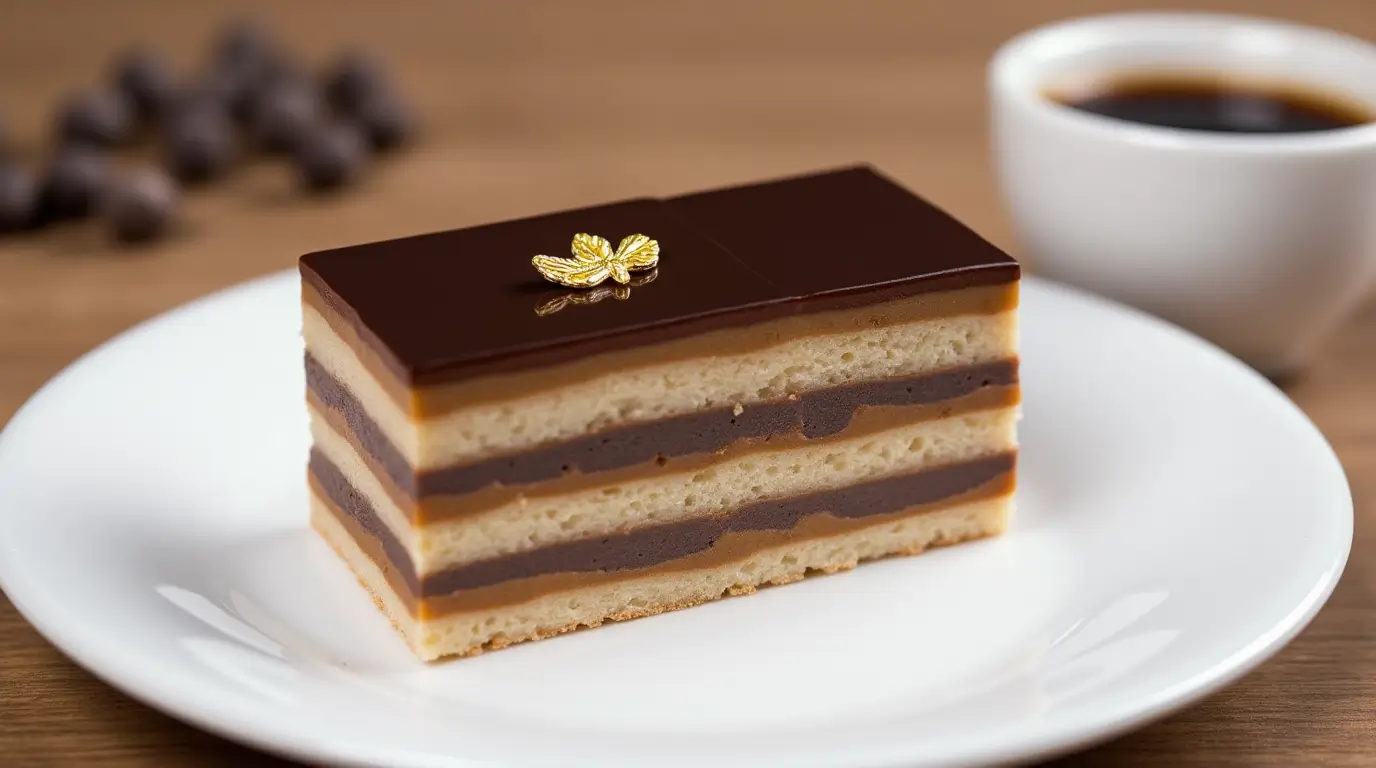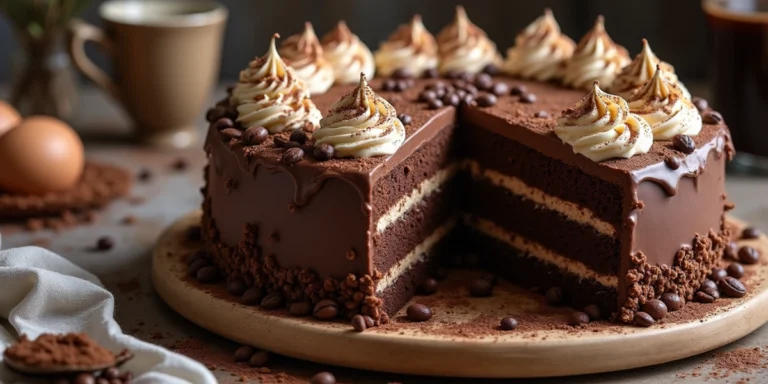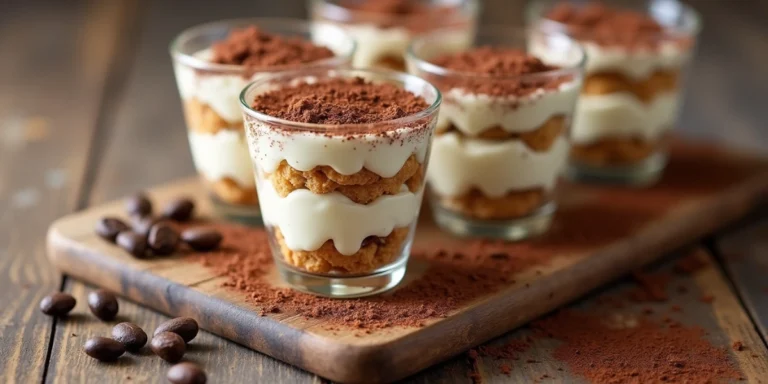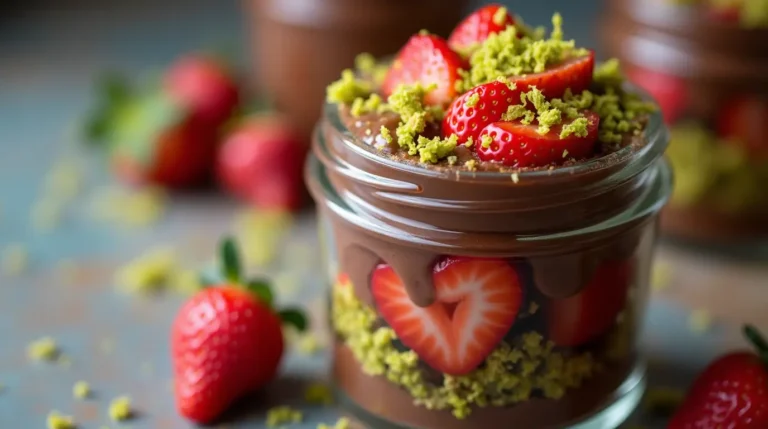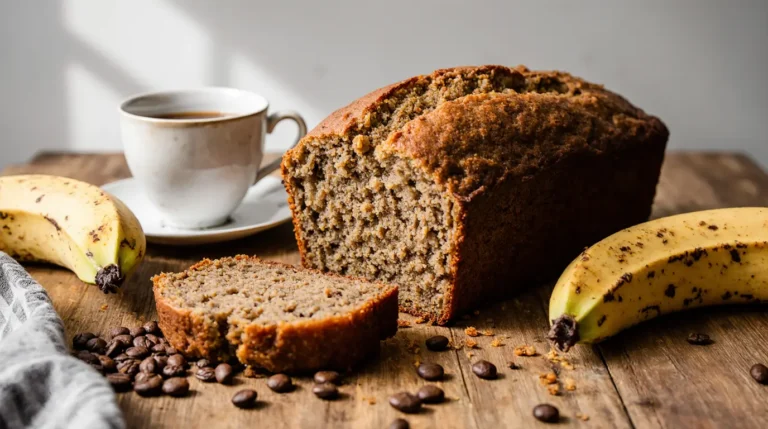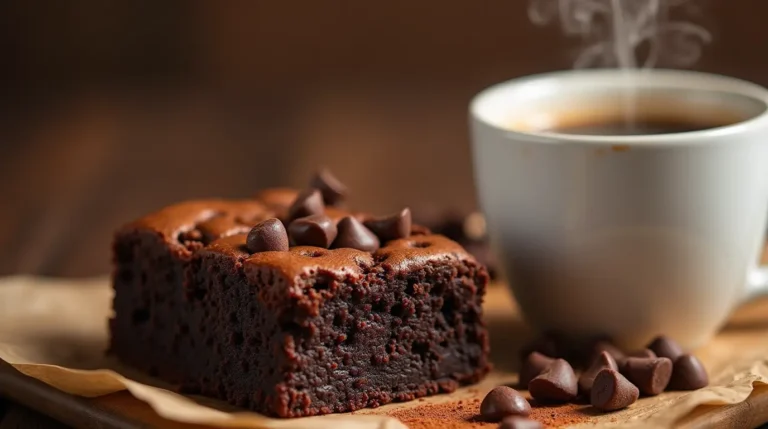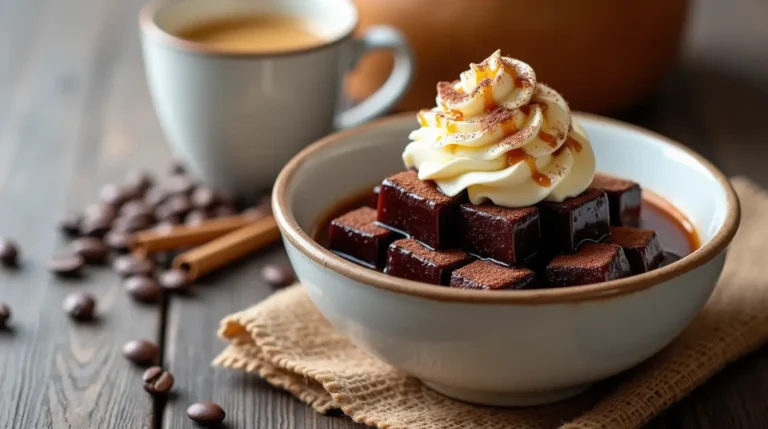How to Make Opera Cake Like a Pro (Step-by-Step Recipe)
Elegant, rich, and irresistibly indulgent — the Opera Cake is a classic French dessert that’s as much a visual masterpiece as it is a treat for the taste buds. With its perfectly even layers of almond sponge (joconde) soaked in coffee syrup, alternating with smooth coffee buttercream and luscious chocolate ganache, this cake delivers a harmonious blend of bold flavors and textures.
Traditionally found in high-end pâtisseries across Paris, the Opera Cake might look intimidating, but with the right technique, it’s surprisingly achievable at home. Whether you’re baking to impress or simply craving a refined dessert, this step-by-step recipe will guide you through making your very own Opera Cake — just like a pro.
What Is an Opera Cake? (And Why You’ll Love It)
Origin & History
The Opera Cake, known in French as Gâteau Opéra, is a luxurious multi-layered dessert that embodies the finesse of French pâtisserie. It’s believed to have originated in Paris in the mid-20th century. While its exact origin is debated, two names are often credited with its creation:
- Maison Dalloyau, a prestigious Parisian pâtisserie, claims to have introduced the cake in the 1950s.
- Gaston Lenôtre, another legendary French pastry chef, is also credited with popularizing or refining the recipe during that era.
The cake was supposedly named “Opera” because its many layers resemble the levels of an opera house stage — and perhaps also to honor the sophistication and artistry of opera itself.
Layers Explained
At its core, the Opera Cake is a precisely constructed, flavor-rich dessert made of thin, evenly stacked layers. Each layer serves a unique purpose, contributing to the overall complexity of taste and texture.
- Joconde (Almond Sponge): A light, flexible sponge cake made with almond flour, eggs, and sugar. Its delicate structure holds the layers without becoming too dense.
- Coffee Syrup: Each sponge layer is soaked in a rich espresso-based syrup, sometimes spiked with coffee liqueur like Kahlúa or Tia Maria, to infuse bold coffee flavor and keep the sponge moist.
- Coffee Buttercream: Made using a traditional French or Swiss meringue buttercream base, flavored with espresso. This component adds creaminess and a mellow coffee note that balances the dark chocolate.
- Chocolate Ganache: A thick, glossy layer of bittersweet chocolate ganache, offering depth and richness that contrasts beautifully with the sweet buttercream.
- Chocolate Glaze (Optional): A sleek, mirror-like dark chocolate glaze can be added on top to seal the cake and give it a pâtisserie-quality finish.
Why It’s Special
There are many reasons why the Opera Cake is beloved by pastry chefs and dessert enthusiasts around the world:
- A Perfect Flavor Balance: The bittersweet chocolate and robust coffee flavors are perfectly balanced by the sweetness of the almond sponge and buttercream.
- Textural Contrast: From the moist sponge to the creamy buttercream and smooth ganache, every bite delivers a multi-textured experience.
- A Showstopper Dessert: With its polished, layered appearance and rich flavor, Opera Cake is perfect for celebrations, dinner parties, or any occasion where you want to impress your guests.
Whether you’re a fan of coffee, chocolate, or simply love elegant French desserts, the Opera Cake delivers on all fronts — flavor, beauty, and sophistication.
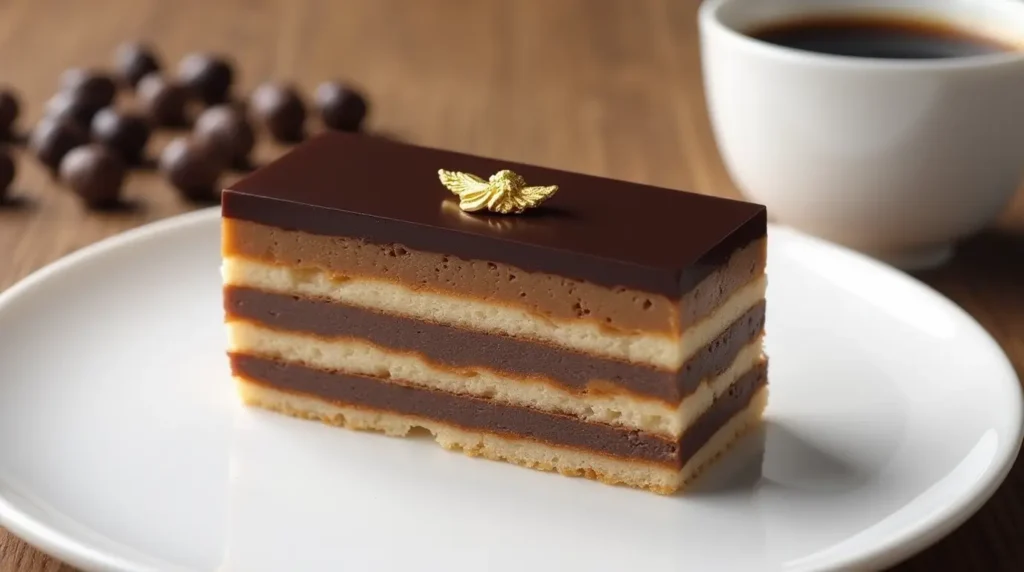
Ingredients & Tools You’ll Need
Making a perfect Opera Cake at home requires precision and planning, but the ingredients themselves are quite accessible — especially if you love to bake. Below is a complete breakdown of each component and the essential tools you’ll need to bring this French classic to life.
Ingredients Table
Here’s a helpful table that outlines the core components of an Opera Cake and the ingredients required for each layer:
| Component | Ingredients |
|---|---|
| Joconde Sponge | Almond flour, cake flour, powdered sugar, whole eggs, egg whites, melted butter |
| Coffee Syrup | Strong brewed espresso or instant coffee, granulated sugar, optional coffee liqueur (like Kahlúa) |
| Coffee Buttercream | Egg yolks, sugar syrup (water + sugar), unsalted butter (room temperature), espresso or coffee extract |
| Chocolate Ganache | High-quality dark chocolate (60–70% cocoa), heavy cream |
| Optional Glaze | Dark chocolate, neutral vegetable oil (such as grapeseed or sunflower oil) |
Pro Tip: Use fresh, high-quality chocolate and real espresso for the most authentic flavor.
Tools You’ll Need
Opera Cake is all about clean layers and precision, so having the right tools can make the process smoother and more enjoyable. Here’s what you’ll want to have on hand:
- Offset Spatula: Essential for spreading buttercream, ganache, and glaze evenly across the thin layers.
- Pastry Brush: Used for soaking the sponge with coffee syrup — ensures even distribution without over-saturating.
- Baking Trays / Sheet Pans: You’ll need large, flat pans (ideally jelly roll pans) to bake the thin joconde layers evenly.
- Stand Mixer or Electric Hand Beater: Helpful for whipping egg whites, yolks, and making buttercream without tiring your arms.
- Candy Thermometer: Useful for boiling sugar to the correct temperature when making the sugar syrup for French buttercream.
Optional but helpful tools:
- Parchment paper for easy release
- Ruler and serrated knife for trimming edges cleanly
- Cake lifter or palette knife for layering
Tips for Success
Before you begin, here are a few expert tips to make your Opera Cake experience successful — and stress-free:
- Chill Between Each Layer: After applying each filling (buttercream or ganache), chill the cake for 15–30 minutes to firm it up before adding the next. This prevents the layers from sliding or blending.
- Use High-Quality Chocolate: Since chocolate is a dominant flavor in the Opera Cake, using premium chocolate (at least 60% cocoa) makes a noticeable difference in taste and texture.
- Be Patient with Assembly: Opera Cake is not a quick dessert. Allow yourself plenty of time to prep, chill, and layer. Rushing can lead to uneven layers or messy edges.
Remember: Precision is key — but perfection isn’t required. Homemade desserts should taste amazing first and look great second!
Step-by-Step Instructions for Assembling Opera Cake
Crafting an Opera Cake requires care, attention to detail, and a bit of patience — but the results are well worth it. Here’s a breakdown of each stage, from baking the joconde sponge to the final chocolate glaze. Follow these steps to build your own professional-quality French Opera Cake at home.
Step 1: Bake the Joconde Sponge
The joconde sponge is a light and flexible almond cake that forms the foundation of every layer in the Opera Cake.
- Whip the Eggs and Sugar
In a mixing bowl, beat whole eggs and powdered sugar together until the mixture is pale, thick, and triples in volume. This gives the sponge its airy structure. - Fold in Almond Flour and Cake Flour
Gently incorporate almond flour and cake flour using a spatula. Be careful not to deflate the batter — the air you whipped in is crucial for a light texture. - Incorporate Whipped Egg Whites
Separately whip egg whites to soft peaks, then fold them into the batter. This adds extra lift and moisture. - Add Melted Butter
Gently stir in cooled, melted butter to enrich the batter without making it too heavy. - Bake in Sheet Pans
Spread the batter evenly into parchment-lined baking trays or jelly roll pans. Bake at 220°C (425°F) for 5–7 minutes until lightly golden. Allow to cool completely before assembly.
Step 2: Make the Fillings
Each component of the filling is responsible for flavor, texture, and contrast. You’ll want to prepare all three elements before starting assembly.
- Brew the Coffee Syrup
Combine strong espresso or instant coffee with sugar in a saucepan. Heat just until the sugar dissolves. For extra flavor, add a splash of coffee liqueur (optional). Let it cool before use. - Prepare the Coffee Buttercream
There are two popular methods for making buttercream: Swiss meringue or French buttercream. Both yield a silky, stable result.- For French buttercream, whip egg yolks while slowly pouring in hot sugar syrup. Beat until thick and cool, then add softened butter and espresso.
- For Swiss meringue, heat egg whites and sugar over a double boiler, then whip to stiff peaks and incorporate butter and coffee extract.
- Make the Chocolate Ganache
Heat heavy cream until simmering, then pour it over finely chopped dark chocolate. Let sit for 1–2 minutes, then stir until glossy and smooth. Let it cool slightly until spreadable but not runny.
Step 3: Layer and Assemble
Now for the fun (and delicate) part: assembling your cake into neat, professional-looking layers.
- Layer 1: Joconde + Coffee Syrup
Place the first layer of almond sponge on your cake board. Use a pastry brush to generously soak it with the cooled coffee syrup. - Layer 2: Coffee Buttercream
Spread a thin, even layer of coffee buttercream using an offset spatula. Chill for 15–20 minutes to set. - Layer 3: Second Sponge + Coffee Syrup + Ganache
Add the next sponge layer, soak it with syrup, and apply a layer of chocolate ganache. Chill again before moving on. - Repeat Layers
Continue alternating sponge, syrup, buttercream, and ganache, finishing with a final sponge layer. Apply a thin layer of ganache or buttercream on top to create a smooth base for the glaze. - Finish with Chocolate Glaze (Optional but Recommended)
Melt dark chocolate with a touch of neutral vegetable oil. Pour over the top of the cake and spread quickly for a glossy, pâtisserie-style finish. - Chill and Trim the Edges
Refrigerate the entire cake for at least 2 hours (or overnight) to firm it up. Once fully set, trim the edges with a hot serrated knife for sharp, clean lines.
Optional: Decorate the top with gold leaf, chocolate shards, or piped cream for an elegant finish.
Conclusion
Creating an Opera Cake at home may seem like a challenge, but with the right technique and a bit of patience, it transforms into a truly rewarding baking experience. Each bite — with its delicate almond sponge, bold espresso syrup, creamy coffee buttercream, and rich chocolate ganache — is a perfect harmony of texture and flavor.
Whether you’re preparing it for a special occasion or simply to treat yourself, this classic French dessert is sure to impress both visually and taste-wise. Plus, the process of layering and assembling each component gives you a deeper appreciation for the art of pâtisserie.
Now that you know how to make an Opera Cake like a pro, why not give it a try and bring a slice of Paris into your kitchen?

